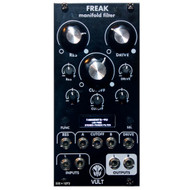Vult - Freak Manifold Filter
by Anatol Locker
Do you remember the Game Boy cartridges that gave you ten games in one module? It’s a rare thing that you see the same design approach on the Eurorack platform. Freak is one of these rare exceptions: It offers 13 digital filter models, each containing additional operation modes like low pass, bandpass or high pass, some even in 24, 18, 12, and 6dB grades.
Something else that’s rare is when software becomes hardware. Vult, the company run by Dr. Leonardo Laguna Ruiz, is known for its numerous VCV Rack software modules, ranging from crazy-sounding VCOs [Tremor, Vessek], experimental virtual CV sources [like the amazing Caudal], to filters with a character that find their way into thousands of VCV Rack patches.
In mid-2019, the first batch of Freak Eurorack modules was ready for pre-ordering, and this digital module holds most of Vult's virtual analog models in just 12 HP. It can be used as a stereo filter or two independent mono filters in “Dual mode”, which was introduced with the latest firmware update, and more filters and functionality will likely be added in future updates.
Freak offers filter simulations that are meant to be playable and fun, and it’s important to understand that the filter types aren’t clones of existing filters—they are interpretations. Let’s take a look at the filter types and its variations:
Boomstick: Basic Sallen-Key filter [LP]. In real life, it’s a simple, low-cost filter design ranging back to early Korg origins.
Debriatus: Chain of Waveshapers [two modes]. Not a filter, but distortion galore. The blunt weapon in Freak’s sonic assault arsenal.
Ferox: CMOS filter [LP, HP, BP, Notch]. A model of a CMOS filter [think of a WASP’ish type filter].
Lateralus: Ladder filter [24, 18, 12, 6dB LP]. Modeled after diode / transistor ladder filters.
Nurage: Low pass gate / filter. Buchla’esque in sound.
Resocomb: Resonant comb filter [2 modes]. Also not a filter, but capable of changing sounds drastically.
Stabile: State-variable filter [LP, BP, HP]. The cleanest and well-behaved filter model.
Tangens: Steiner-Parker filter [LP, HP, BP]. Comes in three flavors [Tangens, Tangens-MS, Tangens-XX]
Unstabile: Circuit bent state variable filter. It emulates a low voltage situation in a circuit, which can sound, well… pretty “unstabile”. Lots of sweet spots to be found here.
Vorg: MS-20 style filter. Modeled after the OTA [Operational Transconductance Amplifier] filter.
Vortex: Polivoks-style filter [LP, BP]. Offers a little extra punch for classic waveforms.
Freak’s front panel isn't made of metal, but is sturdy enough to withstand an extreme style of knob twiddling. The Moog-style knobs for cutoff, resonance, and drive are big enough to “feel the filter”, though the panel isn’t as spacious as a big Moog panel. The display shows bright white on black letters and is easily readable from most angles, and though cycling between all the filter models with just two knobs can take its time, the overall user experience is good. As filters are fun once you start animating them, Freak offers attenuverters for cutoff, resonance, and drive, as well as an “A” and a “B” input. These come into play in Dual Mode and allow for cross-modulation.
To my taste, some models really shine. The Lateralus 18dB ladder filter sounds ridiculously good once you start to animate it, as it’s not the typical squelchy 303-type 18db filter, but a less in-your-face Moog sound. Nurage is capable of becoming really gnarly, Unstabile offers a great sonic variety of filter madness with a lot of sweet spots, and if you want to make your sound completely kaput, Debriatus is your weapon of choice. Finally, Resocomb is a fine addition to the [more or less] traditional filter models. Modulate it with an LFO, and you can get into the depths of lovely flanging effects, ranging from reasonable to sheer obscenity. Pretty much every filter can go into self-oscillation if you’re into that.
In my testing, I started falling in love with the Drive knob. Its sonic capabilities range from a subtle pinch of warmth to a fully blown saturation—sounding fat, comfy, and overall glamorous. Just feed in a dry signal, and you’ll get that extra oomph.
At its price, the Freak is a steal, though there are drawbacks. It’s not a surgical filter you would use as an EQ, as it colors sound in a way that complements a typical analog VCO, and some filters sound very similar unless you drive them to a sweet spot. Also, it’s currently [we’re talking software, right?] not possible to “play the filter” by cranking up the resonance and applying 1V/octave CV.
If you want to get your Freak on, but want to keep costs down,there is a DIY kit available with all of the surface mount components already soldered in, with a pre-programmed micro-controller.
12 HP + 12V 110 mA -12V 13 mA
Price: €225, or DIY kit for €185


